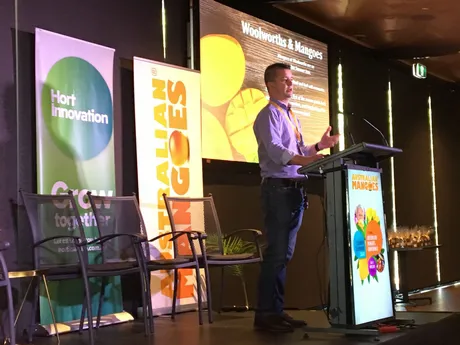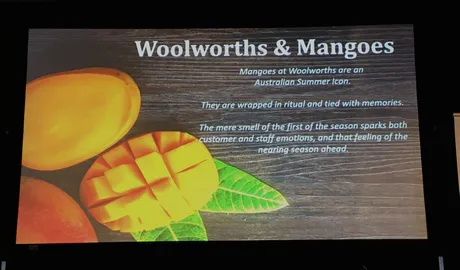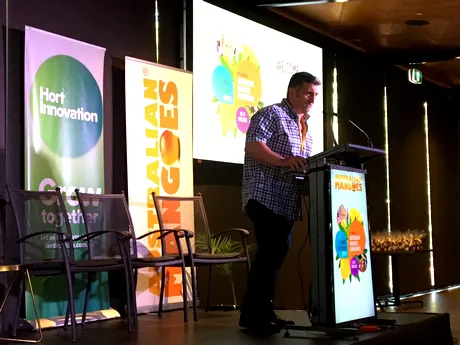One of Australia's leading supermarkets, Woolworths, says there are plenty of opportunities for the mango industry moving forward, as it attempts to turn around what was a challenging season in 2018-19.
Category manager, Dan Scott told the Australian Mango Conference there was a drop in the season-on-season sales in the shared mango market, with a 13 per cent decline in value, driven by people buying less.
"I don't think I would be giving away too much by saying last year was a little bit of a challenging one," he said. "There is plenty of opportunity moving forward into next season obviously. We had 30-50 per cent less volume available out of some regions. We had one of the coldest Novembers that we've ever had. We also had a bit of feedback from our stores that quality and size was a bit of challenge. From a Woolies perspective we certainly could have managed that better and we see that as a real opportunity going into next season."

Photo: Dan Scott
He admits that communication with growers was also an issue in effectively managing the supply, which came in "short-sharp" windows - and that customers were "switching" and buying into to other items of produce, especially earlier in the season. But Mr Scott insists the passion is still there, from the supermarket's produce workers to the store managers, who get excited about the season every year.
"Mangoes are an Australian summer icon, the mere smell of season starts emotions of the staff and customers," he said. "We have a thing called the Woolworths strategy house that gives us guidance of how we can achieve our goals throughout the financial year. The most important thing for mangoes, and all produce, is three pillars; competitive prices, localised range and engaging store experience, but most importantly being fresh every time. We guarantee fresh food any day of the week, any time, so we are not disappointing our customers."

The Woolworths category manager also stresses the importance of accurate forecasts to be able to move the fruit when it is available, adding that if a customer has a bad experience with an item of produce such as a mango, then it will take 6-8 weeks for them to re-purchase.
"6-8 weeks could be the (whole) Darwin season, 6-8 weeks could be the Katherine season or 6-8 weeks could be the North Queensland season," Mr Scott said. "Ultimately if they have a negative experience, it could effectively mean they will miss a whole growing season. So that's why it is absolutely imperative that we get it right from the start."
Harris Farm Markets, produce buyer Carlo Ceravolo agrees the 2018-19 season turned out to be a "clunky" one, with the company having some problems handling the flow of supply.
"Issues were not confined to one region, rather spread across all regions," he said. "As we have eluded to, we had poor weather in Sydney during October, which was a wet month and we saw excessive heat condense the season in Darwin. So, we had these two things going on at the one time. That created no flow, pressure on the markets, transport struggles, fruit arrived late which all culminated in poor quality. Unfortunately, it wasn't until heavy discounting commenced, we began to get traction. But heavy discounting comes at a cost."

Photo: Carlo Ceravolo
He explained that with the emergence of new varieties and plantings, mango volumes will always be strong, but moving considerable crops will take more planning, and has proposed reporting different numbers between the classes of the fruit in forecasts.
"Even when the season is down, it is hard to see one where we go below the 10 million tray mark," Mr Ceravolo said. "I think for a moment the spirit of collaboration was lost with forecasting. There was a phone call made to me asking what was happening in Sydney, my comment was we were all in self-preservation mode. The market was filled with class 2 and class 3 fruit and I think for a period we lost our way with forecasting. There was a significant difference between the forecast and the actual. If forecast is the integral part of what we are doing, then we need to do it better."
Mr Scott says there are plenty of opportunities to increase sales moving forward; including continued and improved quality testing, better communication with growers and addressing sizing issues.
"Our customers have told us that we had a confusing offer at times - small pieces of fruit, different prices, different varieties, different shops and even different sizes in the same shop," he said. "It's very confusing and doesn't make any sense to the customer, and we understand that. That's an opportunity moving forward, and that means tailoring our offer for all our customer groups - whether that be budget, premium or mainstream."
